Gull
Gulls or seagulls are seabirds of the family Laridae in the suborder Lari. They are most closely related to the terns (family Sternidae) and only distantly related to auks, skimmers, and more distantly to the waders. Until the 21st century, most gulls were placed in the genus Larus, but this arrangement is now considered polyphyletic, leading to the resurrection of several genera.[1] An older name for gulls is mews, cognate with German Möwe, Danish måge, Dutch meeuw, and French mouette; this term can still be found in certain regional dialects.[2][3][4]
| Gull Temporal range: Early Oligocene-Present | |
|---|---|
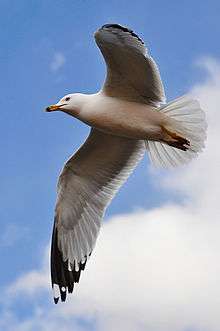 | |
| Adult ring-billed gull | |
| Scientific classification | |
| Kingdom: | Animalia |
| Phylum: | Chordata |
| Class: | Aves |
| Order: | Charadriiformes |
| Suborder: | Lari |
| Family: | Laridae |
| Genera | |
|
11, see text | |
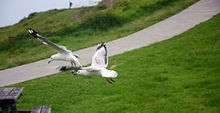
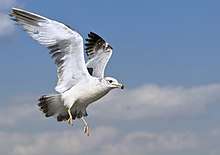
Gulls are typically medium to large birds, usually grey or white, often with black markings on the head or wings. They typically have harsh wailing or squawking calls; stout, longish bills; and webbed feet. Most gulls are ground-nesting carnivores which take live food or scavenge opportunistically, particularly the Larus species. Live food often includes crabs and small fish. Gulls have unhinging jaws which allow them to consume large prey. Gulls are typically coastal or inland species, rarely venturing far out to sea, except for the kittiwakes.[5] The large species take up to four years to attain full adult plumage, but two years is typical for small gulls. Large white-headed gulls are typically long-lived birds, with a maximum age of 49 years recorded for the herring gull.[6]
Gulls nest in large, densely packed, noisy colonies. They lay two or three speckled eggs in nests composed of vegetation. The young are precocial, born with dark mottled down and mobile upon hatching.[7] Gulls are resourceful, inquisitive, and intelligent, the larger species in particular,[8] demonstrating complex methods of communication and a highly developed social structure. For example, many gull colonies display mobbing behavior, attacking and harassing predators and other intruders.[9] Certain species have exhibited tool-use behavior, such as the herring gull, using pieces of bread as bait with which to catch goldfish, for example.[10] Many species of gulls have learned to coexist successfully with humans and have thrived in human habitats.[11] Others rely on kleptoparasitism to get their food. Gulls have been observed preying on live whales, landing on the whale as it surfaces to peck out pieces of flesh.[12]
Description and morphology
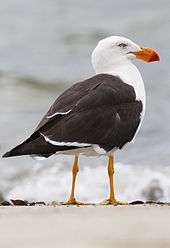
Gulls range in size from the little gull, at 120 g (4.2 oz) and 29 cm (11 in), to the great black-backed gull, at 1.75 kg (3.9 lb) and 76 cm (30 in). They are generally uniform in shape, with heavy bodies, long wings, and moderately long necks. The tails of all but three species are rounded; the exceptions being Sabine's gull and swallow-tailed gulls, which have forked tails, and Ross's gull, which has a wedge-shaped tail. Gulls have moderately long legs, especially when compared to the similar terns, with fully webbed feet. The bill is generally heavy and slightly hooked, with the larger species having stouter bills than the smaller species. The bill colour is often yellow with a red spot for the larger white-headed species and red, dark red or black in the smaller species.[13]
The gulls are generalist feeders. Indeed, they are the least specialised of all the seabirds, and their morphology allows for equal adeptness in swimming, flying, and walking. They are more adept walking on land than most other seabirds, and the smaller gulls tend to be more manoeuvrable while walking. The walking gait of gulls includes a slight side to side motion, something that can be exaggerated in breeding displays. In the air, they are able to hover and they are also able to take off quickly with little space.[13]
The general pattern of plumage in adult gulls is a white body with a darker mantle; the extent to which the mantle is darker varies from pale grey to black. A few species vary in this, the ivory gull is entirely white, and some like the lava gull and Heermann's gull have partly or entirely grey bodies. The wingtips of most species are black, which improves their resistance to wear and tear, usually with a diagnostic pattern of white markings. The head of a gull may be covered by a dark hood or be entirely white. The plumage of the head varies by breeding season; in nonbreeding dark-hooded gulls, the hood is lost, sometimes leaving a single spot behind the eye, and in white-headed gulls, nonbreeding heads may have streaking.[13]
Distribution and habitat
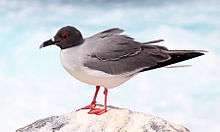
The gulls have a worldwide cosmopolitan distribution. They breed on every continent, including the margins of Antarctica, and are found in the high Arctic, as well. They are less common on tropical islands, although a few species do live on islands such as the Galapagos and New Caledonia. Many species breed in coastal colonies, with a preference for islands, and one species, the grey gull, breeds in the interior of dry deserts far from water. Considerable variety exists in the family and species may breed and feed in marine, freshwater, or terrestrial habitats.[13]
Most gull species are migratory, with birds moving to warmer habitats during the winter, but the extent to which they migrate varies by species. Some migrate long distances, like Franklin's gull, which migrates from Canada to wintering grounds in the south of South America. Other species move much shorter distances and may simply disperse along the coasts near their breeding sites.[13]
Behaviour
Diet and feeding
Charadriiform birds drink salt water, as well as fresh water, as they possess exocrine glands located in supraorbital grooves of the skull by which salt can be excreted through the nostrils to assist the kidneys in maintaining electrolyte balance.[14]
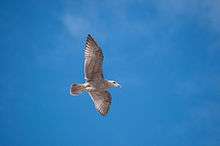
Gulls are highly adaptable feeders that opportunistically take a wide range of prey. The food taken by gulls includes fish and marine and freshwater invertebrates, both alive and already dead, terrestrial arthropods and invertebrates such as insects and earthworms, rodents, eggs, carrion, offal, reptiles, amphibians, plant items such as seeds and fruit, human refuse, chips , and even other birds. No gull species is a single-prey specialist, and no gull species forages using only a single method. The type of food depends on circumstances, and terrestrial prey such as seeds, fruit, and earthworms are more common during the breeding season while marine prey is more common in the nonbreeding season when birds spend more time on large bodies of water.[13]
In addition to taking a wide range of prey, gulls display great versatility in how they obtain prey. Prey can be obtained in the air, on water, or on land. In the air, a number of hooded species are able to hawk insects on the wing; larger species perform this feat more rarely. Gulls on the wing also snatch items both off water and off the ground, and over water they also plunge-dive to catch prey. Again, smaller species are more manoeuvrable and better able to hover-dip fish from the air. Dipping is also common when birds are sitting on the water, and gulls may swim in tight circles or foot paddle to bring marine invertebrates up to the surface. Food is also obtained by searching the ground, often on the shore among sand, mud or rocks. Larger gulls tend to do more feeding in this way. In shallow water gulls may also engage in foot paddling.[15] A method of obtaining prey unique to gulls involves dropping heavy shells of clams and mussels onto hard surfaces.[13] Gulls may fly some distance to find a suitable surface on which to drop shells, and apparently a learned component to the task exists, as older birds are more successful than younger ones.[16] While overall feeding success is a function of age, the diversity in both prey and feeding methods is not. The time taken to learn foraging skills may explain the delayed maturation in gulls.[13]
Gulls that are known to reside in areas where there is a season of plentiful mice have, over the centuries, developed a specialized method of eating them. First, the gull captures the mouse in a field. Next, the gull flies to a convenient body of water. The gull then regurgitates the mouse and dips it in the water. Biologists who first observed this habit observed it between mating pairs of gulls. This initially led them to believe that the female was washing off the mouse after it had been transported to the breeding area. But when lone gulls, both male and female, began to be seen doing this, it was finally concluded that the mouse, being dry the first time it was swallowed, could become lodged in the gull's throat, a conclusion further corroborated when a male gull was seen to struggle with the ejection of the mouse, the mouse being partially ejected before getting stuck in the gull's throat. After 5 to 6 sizable gulps of water, the mouse was sufficiently moistened to allow the gull to completely eject the mouse. By wetting the mouse, the gull ensures that the mouse does not become lodged in its throat.
Gulls have only a limited ability to dive below the water to feed on deeper prey. To obtain prey from deeper down, many species of gulls feed in association with other animals, where marine hunters drive prey to the surface when hunting.[13] Examples of such associations include four species of gulls feeding around plumes of mud brought to the surface by feeding grey whales,[17] and also between orcas (largest dolphin species) and kelp gulls (and other seabirds).[18]
Breeding
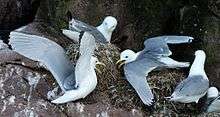
Gulls are monogamous and colonial breeders that display mate fidelity that usually lasts for the life of the pair. Divorce of mated pairs does occur, but it apparently has a social cost that persists for a number of years after the break-up. Gulls also display high levels of site fidelity, returning to the same colony after breeding there once and even usually breeding in the same location within that colony. Colonies can vary from just a few pairs to over a hundred thousand pairs, and may be exclusive to that gull species or shared with other seabird species. A few species nest singly, and single pairs of band-tailed gulls may breed in colonies of other birds. Within colonies, gull pairs are territorial, defending an area of varying size around the nesting site from others of their species. This area can be as large as a 5-m radius around the nest in the herring gull to just a tiny area of cliff ledge in the kittiwakes.[13]
Most gulls breed once a year and have predictable breeding seasons lasting for three to five months. Gulls begin to assemble around the colony for a few weeks prior to occupying the colony. Existing pairs re-establish their pair-bonds, and unpaired birds begin courting. Birds then move back into their territories and new males establish new territories and attempt to court females. Gulls defend their territories from rivals of both sexes through calls and aerial attacks.[13]
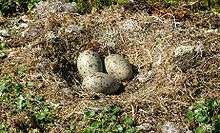
Nest building is also part of the pair-bonding. Gull nests are usually mats of herbaceous matter with a central nest cup. Nests are usually built on the ground, but a few species build nests on cliffs, including the kittiwakes, which almost always nest in such habitats, and in some cases in trees, and high places like Bonaparte's gulls. Species that nest in marshes must construct a nesting platform to keep the nest dry, particularly in species that nest in tidal marshes. Both sexes gather nesting material and build the nest, but the division of labour is not always exactly equal.[13] In coastal towns, many gulls nest on rooftops and can be observed by nearby human residents.
Clutch size is typically three eggs, although it is two in some of the smaller species and only one egg for the swallow-tailed gull. Within colonies, birds synchronise their laying, with synchronisation being higher in larger colonies, although after a certain point, this levels off. The eggs of gulls are usually dark tan to brown or dark olive with dark splotches and scrawl markings, and are well camouflaged. Both sexes incubate the eggs, with incubation bouts lasting between one and four hours during the day and one parent incubating through the night.[13] Research on various bird species including the gull suggests that females form pair bonds with other females to obtain alloparental care for their dependent offspring, a behavior seen in other animal species, like the elephants, wolves, and the fathead minnow.[19]
Incubation lasts between 22 and 26 days, and begins after laying the first egg, although it is discontinuous until the second egg is laid. This means the first two chicks are born close together, and the third chick some time later. Young chicks are brooded by their parents for about one or two weeks, and often at least one parent remains with them, until they fledge, to guard them. Both parents feed the chicks, although early on in the rearing period, the male does most of the feeding and the female most of the brooding and guarding.[13]
Taxonomy
The family Laridae was introduced (as Laridia) by the French polymath Constantine Samuel Rafinesque in 1815.[20][21] The taxonomy of gulls is confused by their widespread distribution zones of hybridization leading to geneflow. Some have traditionally been considered ring species, but recent evidence suggests that this assumption is questionable.[22] Until recently, most gulls were placed in the genus Larus, but this arrangement is now known to be polyphyletic, leading to the resurrection of the genera Ichthyaetus, Chroicocephalus, Leucophaeus, Saundersilarus, and Hydrocoloeus.[1] Some English names refer to species complexes within the group:
- Large white-headed gull is used to describe the 18 or so herring gull-like species from California gull to lesser black-backed gull in the taxonomic list below.
- White-winged gull is used to describe the four pale-winged, high Arctic-breeding taxa within the former group; these are Iceland gull, glaucous gull, Thayer's gull, and Kumlien's gull.
Hybridisation between species of gull occurs quite frequently, although to varying degrees depending on the species involved. The taxonomy of the large white-headed gulls is particularly complicated.
In common usage, members of various gull species are often referred to as sea gulls or seagulls; however, "seagull" is a layperson's term that is not used by most ornithologists and biologists. This name is used informally to refer to a common local species or all gulls in general, and has no fixed taxonomic meaning.[23] In common usage, gull-like seabirds that are not technically gulls (e.g. albatrosses, fulmars, terns, and skuas) may also be referred to as seagulls by the layperson.
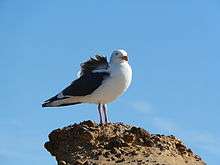
The American Ornithologists' Union combines the Sternidae, Stercorariidae, and Rhynchopidae as subfamilies in the family Laridae, but recent research[24][25][26] indicates this is incorrect.
List of species
.jpg)
This is a list of gull species, presented in taxonomic sequence.
.jpg)
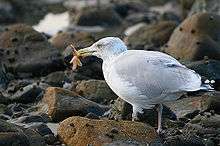
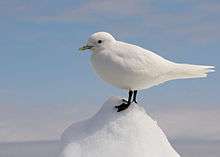
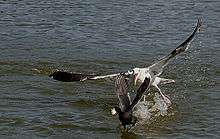
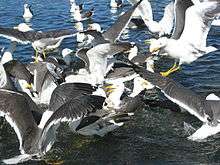
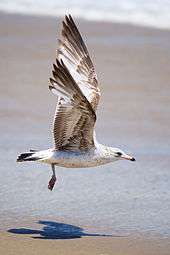
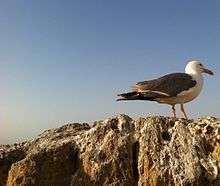
Genus Larus
- Pacific gull, Larus pacificus
- Belcher's gull, Larus belcheri
- Olrog's gull, Larus atlanticus
- Black-tailed gull, Larus crassirostris
- Heermann's gull, Larus heermanni
- Common gull or mew gull, Larus canus
- Ring-billed gull, Larus delawarensis
- California gull, Larus californicus
- Great black-backed gull, Larus marinus
- Kelp gull, Larus dominicanus (called "southern black-backed gull" or "karoro" in New Zealand)
- Cape gull, Larus dominicanus vetula
- Glaucous-winged gull, Larus glaucescens
- Western gull, Larus occidentalis
- Yellow-footed gull, Larus livens
- Glaucous gull, Larus hyperboreus
- Iceland gull, Larus glaucoides
- Kumlien's gull, Larus glaucoides kumlieni
- Thayer's gull, Larus glaucoides thayeri
- European herring gull, Larus argentatus
- American herring gull, Larus smithsonianus
- Caspian gull, Larus cachinnans
- Yellow-legged gull, Larus michahellis
- East Siberian herring gull, Larus vegae
- Armenian gull, Larus armenicus
- Slaty-backed gull, Larus schistisagus
- Lesser black-backed gull, Larus fuscus
- Heuglin's gull, Larus fuscus heuglini
Genus Ichthyaetus
- White-eyed gull, Ichthyaetus leucophthalmus
- Sooty gull, Ichthyaetus hemprichii
- Great black-headed gull or Pallas's gull, Ichthyaetus ichthyaetus
- Audouin's gull, Ichthyaetus audouinii
- Mediterranean gull, Ichthyaetus melanocephalus
- Relict gull, Ichthyaetus relictus
Genus Leucophaeus
- Dolphin gull, Leucophaeus scoresbii
- Laughing gull, Leucophaeus atricilla
- Franklin's gull, Leucophaeus pipixcan
- Lava gull, Leucophaeus fuliginosus
- Gray gull, Leucophaeus modestus
Genus Chroicocephalus
- Silver gull, Chroicocephalus novaehollandiae
- Red-billed gull, Chroicocephalus novaehollandiae scopulinus
- Hartlaub's gull, Chroicocephalus hartlaubii
- Brown-hooded gull, Chroicocephalus maculipennis
- Gray-headed gull, Chroicocephalus cirrocephalus
- Andean gull, Chroicocephalus serranus
- Black-billed gull, Chroicocephalus bulleri
- Brown-headed gull, Chroicocephalus brunnicephalus
- Black-headed gull, Chroicocephalus ridibundus
- Slender-billed gull, Chroicocephalus genei
- Bonaparte's gull, Chroicocephalus philadelphia
- Saunders's gull, Chroicocephalus saundersi
Genus Hydrocoloeus (may include Rhodostethia)
- Little gull, Hydrocoloeus minutus
Genus Rhodostethia
- Ross's gull, Rhodostethia rosea
Genus Rissa
- Black-legged kittiwake, Rissa tridactyla
- Red-legged kittiwake, Rissa brevirostris
Genus Pagophila
- Ivory gull, Pagophila eburnea
Genus Xema
- Sabine's gull, Xema sabini
Genus Creagrus
- Swallow-tailed gull, Creagrus furcatus
Evolution
The Laridae are known from not-yet-published fossil evidence since the Early Oligocene, some 30–33 million years ago. Three gull-like species were described by Alphonse Milne-Edwards from the early Miocene of Saint-Gérand-le-Puy, France. A fossil gull from the Middle to Late Miocene of Cherry County, Nebraska, USA is placed in the prehistoric genus Gaviota;[27] apart from this and the undescribed Early Oligocene fossil, all prehistoric species were tentatively assigned to the modern genus Larus. Among those of them that have been confirmed as gulls, Milne-Edwards' "Larus" elegans and "L." totanoides from the Late Oligocene/Early Miocene of southeast France have since been separated in Laricola.[28]
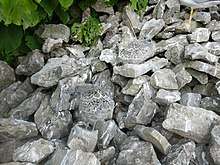
References
- Pons J.-M.; Hassanin A.; Crochet P.-A. (2005). "Phylogenetic relationships within the Laridae (Charadriiformes: Aves) inferred from mitochondrial markers". Molecular Phylogenetics and Evolution. 37 (3): 686–99. doi:10.1016/j.ympev.2005.05.011. PMID 16054399.
- "Webster's Revised Unabridged Dictionary, 1913". Archived from the original on 4 November 2013. Retrieved 13 July 2013.
- The American Heritage Dictionary of the English Language, Fourth Edition
- Merriam-Webster Online
- "Herring Gull". The Cornell Lab of Ornithology. 3 August 2011.
- "AnAge entry for Larus argentatus". The Animal Ageing and Longevity Database. Retrieved 23 November 2008.
- Harrison, Colin J.O. (1991). Forshaw, Joseph (ed.). Encyclopaedia of Animals: Birds. London: Merehurst Press. pp. 109–111. ISBN 978-1-85391-186-6.
- "Gulls and man". The Royal Society for the Protection of Birds. 13 August 2007. Retrieved 4 January 2010.
- Alcock, J. (1998) Animal Behavior: An Evolutionary Approach (7th edition). Sinauer Associates, Inc. Sunderland, Massachusetts. ISBN 0-87893-009-4
- Henry, Pierre-Yves; Jean-Christophe Aznar (June 2006). "Tool-use in Charadrii: Active Bait-Fishing by a Herring Gull". Waterbirds. 29 (2): 233–234. doi:10.1675/1524-4695(2006)29[233:TICABB]2.0.CO;2.
- "Seagull becomes crisp shoplifter". BBC News. 20 July 2007.
- "Gulls' vicious attacks on whales". BBC News. 21 June 2009.
- Burger, Alan; Gochfeld, Michael (1996). "Family Laridae (Gulls)". In del Hoyo, Josep; Elliott, Andrew; Sargatal, Jordi (eds.). Handbook of the Birds of the World. Volume 3, Hoatzin to Auks. Barcelona: Lynx Edicions. pp. 572–599. ISBN 978-84-87334-20-7.
- Dowdey, Sarah (9 July 2009). "How do seagulls drink saltwater?". HowStuffWorks. Archived from the original on 27 March 2013. Retrieved 20 March 2013.
- Buckley, P. A. (January–December 1966). "Foot-paddling in Four American Gulls, with Comments on its Possible Function and Stimulation". Ethology. 23 (4): 395–402. doi:10.1111/j.1439-0310.1966.tb01603.x (inactive 22 January 2020).
- Ingolfsson, Agnar; Bruce T. Estrella (1978). "The development of shell-cracking behavior in herring gulls" (PDF). The Auk. 95 (3): 577–579.
- Harrison, Craig (1979). "The Association of Marine Birds and Feeding Gray Whales" (PDF). Condor. 81 (1): 93–95. doi:10.2307/1367866. JSTOR 1367866.
- Ridoux, Vincent (1987). "Feeding association between seabirds and killer whales, Orcinus orca, around subantarctic Crozet Islands". Canadian Journal of Zoology. 65 (8): 2113–2115. doi:10.1139/z87-324.
- Riedman, Marianne L. (1982). "The Evolution of Alloparental Care in Mammals and Birds". The Quarterly Review of Biology. 57 (4): 405–435. doi:10.1086/412936.
- Rafinesque, Constantine Samuel (1815). Analyse de la nature ou, Tableau de l'univers et des corps organisés (in French). 1815. Palermo: Self-published. p. 72.
- Bock, Walter J. (1994). History and Nomenclature of Avian Family-Group Names. Bulletin of the American Museum of Natural History. Number 222. New York: American Museum of Natural History. pp. 138, 252. hdl:2246/830.
- Liebers, Dorit; de Knijff, Peter; Helbig, Andreas J. (2004). "The herring gull complex is not a ring species". Proceedings: Biological Sciences. 271 (1542): 893–901. doi:10.1098/rspb.2004.2679. PMC 1691675. PMID 15255043.
- Hayward, Ian (24 July 2009). "Are sea gulls actually called sea gulls or is there another name for them?". The RSPB: Ask An Expert. Royal Society for the Protection of Birds. Retrieved 12 September 2018.
- Paton, Tara A.; Baker, Allan J. (2006). "Sequences from 14 mitochondrial genes provide a well-supported phylogeny of the Charadriiform birds congruent with the nuclear RAG-1 tree". Molecular Phylogenetics and Evolution. 39 (3): 657–667. doi:10.1016/j.ympev.2006.01.011. PMID 16531074.
- Paton, T. A.; Baker, A. J.; Groth, J. G.; Barrowclough, G. F. (2003). "RAG-1 sequences resolve phylogenetic relationships within charadriiform birds". Molecular Phylogenetics and Evolution. 29 (2): 268–278. doi:10.1016/S1055-7903(03)00098-8. PMID 13678682.
- Thomas, Gavin H.; Wills, Matthew A.; Székely, Tamás (2004). "A supertree approach to shorebird phylogeny". BMC Evol. Biol. 4 (1): 28. doi:10.1186/1471-2148-4-28. PMC 515296. PMID 15329156.
- Miller, A. H. and Sibley (1941) described Gaviota niobrara from the upper Miocene of Nebraska
- Pietri, Vanesa L. De (2011). "A revision of the Lari (Aves, Charadriiformes) from the early Miocene of Saint-Gérand-le-Puy (Allier, France)". Journal of Vertebrate Paleontology. 31 (4): 812–828. doi:10.1080/02724634.2011.586663.
Further reading
External links
| Look up gull in Wiktionary, the free dictionary. |
| Wikimedia Commons has media related to Laridae. |
| Wikispecies has information related to Laridae |
- Rudy's Gull-index Pictures of less well-known plumages of large gulls
- Gull videos on the Internet Bird Collection